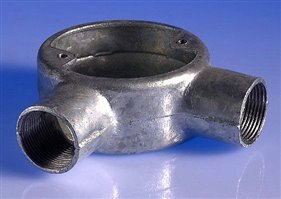Looking around the internet I've found very little to help me understand how electrical steel conduit is installed.....but I'm sure someone on Element14 knows the answers 
The question relates to the 20/25mm galvanised steel conduit often used in the UK - this comes as 3m lengths with a external make thread on one end and a female coupler on the other. Unless the fittings are 3m apart the conduit requires cutting and a new thread to be formed, which I already have tools for. The outlets/fixings also come with pre-cut threads; and example of the 90 degree box is shown below:
Whilst I can envisage fixing one of the box outlets to the required position and screwing in a piece of cut/pre-threaded conduit I wonder how the next fitting is added. Assuming that is a cut end which I have added a thread to this second fixing would need rotating onto the conduit. Because the first fixing is on the wall there would be no clearance to rotate the second fixing without putting strain on the existing system, this is especially true when the next fitting has additional bosses on it or as the system design grows.
Maybe the entire system is designed and then mounted to the wall ? I would imagine that could result in a very heavy setup plus inaccuracies in getting the fittings where required.




